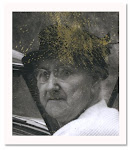I don’t find most cabinet cards particularly interesting because though, like all photographs, they capture a moment in time, cabinet cards capture a contrived moment. There’s nothing spontaneous about them. In fact, we learn only the superficial about the subjects. We may be able to determine a bit about their social status by analyzing the style of their clothing, which can also lead to dating the shot. Unless we have a name for the subject they’ll forever be a relatively blank slate. It’s virtually impossible to see any emotion in the blank stares that were required.


Click on either image to see them larger.
What I do find interesting are the photographers who took the shots. Unlike vintage snapshots where the photographers are rarely known, in fact virtually unthought of, with cabinet cards we see the specific work of the person behind the lens. We see a connection between the subject and the photographer when we are given a photographer’s name. We can search for more work by the same person.
This photo is from my friend Bert’s collection. A plain woman in a rather plain dress taken at the Bliss Brother’s Studio in Buffalo, New York.

Bliss Brothers (Harry A. and Frank H.) are sons of Horace L. Bliss, one of the oldest living photographers in Buffalo. He was born in Hartford, Conn., October 6, 1823, came to Buffalo about 1854 and learned the photographic business. In 1859 he established a photograph gallery at the corner of Main and Eagle streets, and successfully continued until 1886, when he retired on account of ill health. He made a specialty of outside photographs and also did considerable commercial work.
Harry A. and Frank H. Bliss are natives of Buffalo; the former was born February 28, 1866, and the latter February 6, 1858. Both were educated in the Buffalo public and high schools, learned photography with their father, and when the latter retired in 1886 succeeded him in business under the firm name of Bliss Brothers. Soon after starting, their portrait and commercial work had grown to such proportions that they separated the two, locating the latter on Oak street near Genesee, and continuing the former at the corner of Main and Eagle streets. They are among the leaders in both branches in Buffalo, and enjoy the highest reputation for artistic work. (SOURCE: Our County and Its People: A descriptive work on Erie County, New York; edited by Truman C. White; The Boston History Company, Publishes 1898)The photo above of their studio is a portion of a larger photo at Shorpy.
Do an online search for “Bliss Bros” and you’ll find a variety of work, but nothing that really stands out as exceptional. Examples can be seen here: 1, 2, 3, 4, 5, 6, 7
However, researching the Bliss Brothers did shine a light on one of the big problems with researching anything on the net. How do you verify what you’re reading when posts everywhere are often nothing more than samplings from someone else's work? I give you the following example.
I was willing to give the site the benefit of the doubt until I found the photo on Wikipedia claiming the photographer was the DeYoung Photography Studio located at 826 Broadway in New York City. This same credit is referenced at several other sites.
So which is true? Bliss Brothers or DeYoung? Does it even matter? Well, in our celebrity conscious society the idea that the photographer who took the above boring shot of the plain woman also might have taken a shot of the Sundance Kid and Etta Place does matter. We know the history, though sketchy, of Sundance and Etta. We have a reference point. We don’t have any reference point for the plain woman other than Buffalo, New York. And sadly, I have yet to find a copy of the Sundance and Etta shot with any markings indicating the photographer. I’ll go with DeYoung simply because so many other sites repeat this information. How accurate is it? I haven’t a clue.

















An interesting post. I've also discovered far more history in the photographers than in their subjects. They often seem to be the first modern community archivists, recording the people of urban and rural life.
ReplyDeleteAnd while I agree that many cabinet cards look contrived, that is true of almost any studio portrait, antique or modern. A talented photographer has that rare quality to highlight the subject's real character and make it stand out in the photo.
I agree completely. A really good portrait photographer captures more than the surface, well, until I look at my senior yearbook and all of us dressed in the traditional boring outfits with the phony smiles. Black jacket with black tie for the guys and the stupid black off the shoulder thingie the girls had to wear. In those days, 1960s, senior photos were as bad as cabinet cards. Actually cabinet cards were better because the people got to choose what they wore.
ReplyDeleteThe Library of Congress has the original cabinet card photograph of Longbaugh and Place and the maker's name and address ("DeYoung's, Broadway & 17th St., New York") is clearly marked on the lower left of the card. https://www.loc.gov/resource/ds.08269/
ReplyDeleteThank you for clearing that up. I appreciate it.
DeleteI think De Youngs is original photo. One marked from Bliss Brothers in Buffalo may have been copied by from that photo by the Pinkertons or Sundance, Etta. On the black and white print from Bliss Brothers it says "From different print"
ReplyDeleteThank you. I appreciate the update.
Delete